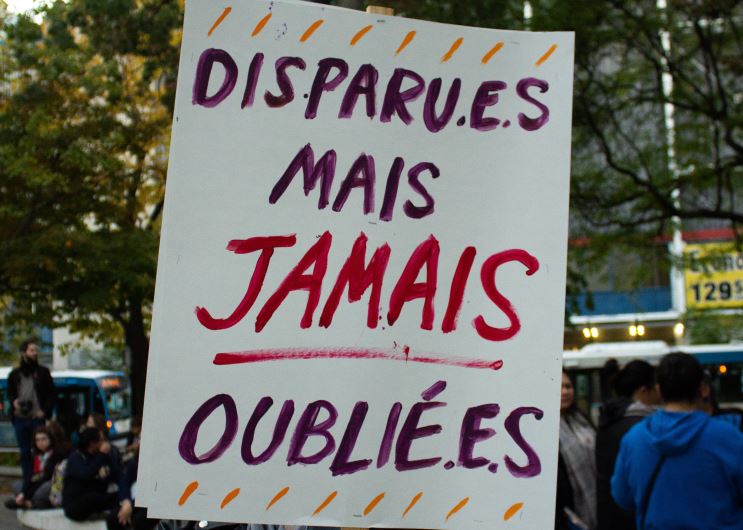“I hope we don’t have these vigils anymore,” Jessica Quijano said to the crowd gathered at Cabot Square on Thursday, October 4, to march for Missing and Murdered Indigenous Women, Girls, and Two-Spirit people. At the vigil called Love, Rage, and Solidarity, demonstrators held candles, and on the stage hung a red dress (a symbol of MMIWG2 created by Metis artist Jamie Black). Quijano is the project coordinator of the Iskweu Project at the Native Women’s Shelter of Montreal. Her comments expressed a common sentiment among all the speakers and marchers. This was the 13th annual vigil for MMIWG2, which left many people wondering when there will be justice.
Cabot Square is blocks away from Chez Doris, a daytime women’s shelter that also offers specific services for Indigenous women. Their services include an onsite caseworker who provides Inuit assistance, and an Indigenous caseworker who addresses housing issues and ensuring housing stability. Open Door, a drop-in centre for homeless and low-income people, was previously located across the square, operating out of St. Stephen’s Anglican Church. As previously reported in the Daily, this summer, a condominium developer bought the building and Open Door was forced to vacate. Open Door is scheduled to relocate to Notre-Dame-de-la Salette in Milton Parc at the end of October.
Quijano explained the importance of Open Door to Cabot Square, and her anger that they were “being pushed out.” She called for more shelters in Montreal, and specifically more “wet shelters” that provide services for homeless people who are intoxicated.
Other spaces open to the city’s homeless and low-income population, like Atwater Library, also border the park. It is because of this resource hub that many Indigenous people in precarious housing situations congregate in Cabot Square. This summer, police began regularly patrolling the park and surrounding street corners, handing out tickets.
Quijano spoke to the CBC in July, explaining that “when I have a woman who is maybe a victim of violence, and who has been sexually assaulted, she does not want to go to police because she’s ticketed on a daily basis.”
There is a great gap between Indigenous communities and the police force when it comes to reporting. According to the Montreal’s Native Women’s Shelter, police do not act fast enough on cases related to Indigenous persons, and most Indigenous people do not feel safe approaching police. With luxury condos soon to open over Cabot Square, there are concerns that Indigenous interests will be further breached, and their presence further suppressed.
“[The Canadian government] still want[s] our land,” said Ellen Gabriel, also known as Katsi’tsakwas, a Mohawk activist and artist from the Kanehsatà:ke Nation. “Did you hear any specifics about us in the [Quebec election] campaigns? We were the last on the list.”
Two women in the community of and around Cabot Square took the stage. “We get lost, stolen, betrayed,” they said. “I try to be heard… Everybody tries to be heard.” The demonstrators marched down Saint Catherine Street, led by a drumbeat courtesy of powwow performers, the Buffalo Hat Singers. Chanting “Break the silence, end the violence,” the crowd marched to Phillip Square while holding candles.

